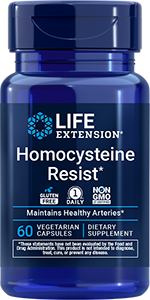
How Can TMG Help Your Homocysteine Levels?
Published: June 2025
When people think about biomarkers for cardiovascular and metabolic health, some of the big ones that come to mind are cholesterol, glucose and blood pressure.
But what about homocysteine?
This little-known, often overlooked biomarker can give you a clearer picture of the health of your heart, brain, liver and more—and the good news is that it often just takes a good diet and proper supplementation to maintain healthy levels.
TMG supplements, otherwise known as betaine, are a tried-and-true way to support healthy homocysteine balance.
If this is all new to you, this article will help explain what you need to know!
What is homocysteine and why should you care?
So, what exactly is homocysteine, anyway? It is the breakdown product of another amino acid called methionine, which is essential, meaning it can only be obtained through dietary sources since our bodies don't make it themselves.
But just because methionine is "essential" does not mean more is better! Having the right amount (not too high, not too low) is important for whole-body wellness because both homocysteine and methionine play critical roles in various biochemical processes.
Here are some of the benefits of normal homocysteine levels:
Heart and brain health:
Meta-analyses have shown that less than optimal homocysteine levels are associated with unsupported vascular and neurological systems.Liver health:
A meta-analysis of 22 observational studies comprising around 30,000 people found that higher serum folate levels were associated with controlled homocysteine levels and improved liver health.Kidney health:
A study showed that genetically predicted sub-optimal homocysteine levels were associated with less-than-ideal levels of eGFR, which is an important marker of kidney health.
Ensuring you obtain a proper amount of methionine is important, especially in old age, as it is also a precursor to the liver- and immune-supporting nutrient cysteine, the heart-healthy taurine, and the mood- and liver-supporting SAMe.
How do I support healthy homocysteine levels?
Your diet has a huge influence on your homocysteine balance. If you eat a lot of methionine, your homocysteine levels may be too high. The highest sources of methionine are meats, fish, dairy, and cheeses, tofu, and Brazil nuts. So, if you're a frequent consumer of these foods, you might want to get your homocysteine checked!
If the results show your levels are not great, you might not need to cut back on all these foods, but you'll need to at least increase your intake of other nutrients that counterbalance their impact.
And one of the most effective nutrients for supporting healthy homocysteine balance is TMG.
What is TMG (Trimethylglycine)?
TMG stands for trimethylglycine. So, what does trimethylglycine mean? It's a combo of the words "tri," "methyl," and "glycine." The last and first of these words are easy enough: glycine is an amino acid; tri means three. For TMG, the "tri" refers to the methyl groups, of which there are a total of three.
What is a "methyl" group, the middle part of this word? This term just means one carbon attached to three hydrogens. (Methyl groups are ubiquitous throughout the body and are involved in many important biological processes.) TMG is just three methyl groups attached to a glycine.
Glycine supplements are often taken to promote healthy sleep, but in the TMG form, it acts primarily as a methyl donor to help keep homocysteine levels in healthy ranges.
Incidentally, TMG has a few other names, including betaine and glycine betaine. Note that although betaine is a common name for TMG, "betaine HCL supplements" are different, and are used for digestive health rather than for homocysteine.
Science Lesson: How TMG Influences Homocysteine
To understand how trimethylglycine promotes healthy homocysteine levels requires an understanding of methylation and methionine metabolism, which may sound complicated, but bear with me: it's not as bad as it sounds!
Here's how the process works:
- An enzyme acts on methionine in the body, adding an adenosyl group to form a compound called SAMe (S-adenosyl methionine).
- Another enzyme converts S-adenosyl methionine into S-adenosyl-L-homocysteine by transferring a methyl group to another molecule.
- A third enzyme removes the adenosyl group, producing homocysteine.
If you're following me with what's been added and subtracted, all homocysteine needs is another methyl group donation to convert it back to methionine.
That's where TMG comes in! When it encounters homocysteine, TMG springs into action to donate a methyl group to homocysteine and that converts the homocysteine right back into methionine!
This little switcheroo ensures you don't have more homocysteine than you need. (If we didn't mention it already, healthy homocysteine levels are quite a balancing act!)
Who should consider TMG supplementation?
The only way to know for sure if you should be supplementing with TMG is by taking a homocysteine blood test. Life Extension believes it should be at least under 12 µmol/L, with less than 8 µmol/L being considered ideal (although the latter may be more difficult for some people to attain).
Aging individuals are more at risk of having less than optimal homocysteine levels, because homocysteine levels tend to increase with age.
In youth, they typically stay in healthy ranges; However, some people have MTHFR mutations, which may cause unsupported homocysteine levels even in young people. You won't know if you have this mutation without a genetic test.
How much TMG should you take?
Depending on what your homocysteine concentrations are, most people just need to take between 500-1000 milligrams to support healthy levels and their neurological and cardiovascular health. You can find TMG in a capsule and in a powder form to give you options.
If you've got less than optimal homocysteine levels, consider also taking B vitamins: B6, B9, or B12. This is because B vitamins help to optimize homocysteine metabolism as well as other vitamin B-dependent activities. In addition, an analysis of prospective studies totaling about 400,000 people found that an increased intake of vitamin B6 and folate was associated with improved cerebrovascular health.
Explore Our Best Heart Health Supplements
What’s the best diet for homocysteine balance?
Eat less: Animal products, tofu, and Brazil nuts.
Eat more: Beets, spinach, and whole grains (high in TMG). Also have more of TMG's precursor choline, which is an essential nutrient and B vitamin-like compound that also has positive brain health effects. Fish, oysters, beans, and soybeans are all great sources of choline.
Why doesn’t my doctor talk about homocysteine?
Wondering why your primary care physician might keep tabs on your cholesterol, blood pressure and glucose levels but may not test homocysteine? You're not alone! People have fought a long battle to get homocysteine recognized and accepted as an important biomarker of cardiovascular health.
This dates back a long way to when the link between homocysteine and vascular health was first proposed by a Harvard researcher named Kilmer McCully in the 1960s.
It did not start to get attention from health care professionals until the 1990s when the famous Framingham Heart Study discovered that vascular health was related to healthy homocysteine levels. Then a study by the Harvard School of Public Health found a three-fold link between homocysteine levels and vascular health.
This put the spotlight on homocysteine for some, but many people are unaware of its importance and still neglect to test it.
If your homocysteine hasn't been tested, don't be afraid to request it! A homocysteine test can also be purchased directly at Life Extension along with a plethora of other biomarkers. And remember that eating a healthy diet and supplementing are a great way to cover your bases.
References
- Brosnan JT, Brosnan ME. "The sulfur-containing amino acids: an overview." J Nutr. June 2006. https://pubmed.ncbi.nlm.nih.gov/16702333/
- Chen L, et al. "Dietary Intake of Homocysteine Metabolism-Related B-Vitamins and the Risk of Stroke: A Dose-Response Meta-Analysis of Prospective Studies." Adv Nutr. November 2020. https://pubmed.ncbi.nlm.nih.gov/32503038/
- Olaso-Gonzalez G, et al. "Impact of supplementation with vitamins B6 , B12 , and/or folic acid on the reduction of homocysteine levels in patients with mild cognitive impairment: A systematic review." IUBMB Life. January 2022. https://pubmed.ncbi.nlm.nih.gov/34058062/
- Ostrakhovitch EA, Tabibzadeh S. "Homocysteine and age-associated disorders." Ageing Res Rev. January 2019. https://pubmed.ncbi.nlm.nih.gov/30391754/
- Park S, et al. "Causal Effects of Homocysteine, Folate, and Cobalamin on Kidney Function: A Mendelian Randomization Study." Nutrients. March 2021. https://pubmed.ncbi.nlm.nih.gov/33799553/
- Rabelo NN, et al. "Homocysteine is associated with higher risks of ischemic stroke: A systematic review and meta-analysis." PLoS One. October 2022. https://pubmed.ncbi.nlm.nih.gov/36227950/
- Stampfer MJ, et al. "A prospective study of plasma homocyst(e)ine and risk of myocardial infarction in US physicians." JAMA. August 1992. https://pubmed.ncbi.nlm.nih.gov/1640615/
- Surofchy DD, et al. "Food, Acid Supplementation and Drug Absorption - a Complicated Gastric Mix: a Randomized Control Trial." Pharm Res. September 2019. https://pubmed.ncbi.nlm.nih.gov/31485804/
- Ventura P, et al. "Hyperhomocysteinemia and related factors in 600 hospitalized elderly subjects." Metabolism. December 2001. https://pubmed.ncbi.nlm.nih.gov/11735095/
- Wang B, et al. "Systematic review and meta-analysis of the correlation between plasma homocysteine levels and coronary heart disease." J Thorac Dis. March 2022. https://pubmed.ncbi.nlm.nih.gov/35399239/
- Whitbread D. "Top 10 Foods Highest in Methionine." MyFoodData. November 2024. https://www.myfooddata.com/articles/high-methionine-foods.php
- Yuan S, et al. "Homocysteine, folate, and nonalcoholic fatty liver disease: a systematic review with meta-analysis and Mendelian randomization investigation." Am J Clin Nutr. December 2022. https://pubmed.ncbi.nlm.nih.gov/36205540/
- Zarembska E, et al. "The Implication of a Polymorphism in the Methylenetetrahydrofolate Reductase Gene in Homocysteine Metabolism and Related Civilisation Diseases." Int J Mol Sci. December 2023. https://pubmed.ncbi.nlm.nih.gov/38203363/
- "Kilmer McCully, 91, Dies; Pathologist Vindicated on Heart Disease Theory." The New York Times. https://www.nytimes.com/2025/03/21/science/kilmer-mccully-dead.html
- "A Timeline of Milestones from The Framingham Heart Study." Framingham Heart Study. https://www.framingham.com/heart/timeline.htm
Always be in the know!
Access the latest deals, wellness news, expert health tips & more!










